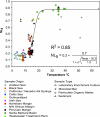Impact of temperature on ladderane lipid distribution in anammox bacteria
- PMID: 20048066
- PMCID: PMC2832374
- DOI: 10.1128/AEM.01796-09
Impact of temperature on ladderane lipid distribution in anammox bacteria
Abstract
Anaerobic ammonium-oxidizing (anammox) bacteria have the unique ability to synthesize fatty acids containing linearly concatenated cyclobutane rings, termed "ladderane lipids." In this study we investigated the effect of temperature on the ladderane lipid composition and distribution in anammox enrichment cultures, marine particulate organic matter, and surface sediments. Under controlled laboratory conditions we observed an increase in the amount of C(20) [5]-ladderane fatty acids compared with the amount of C(18) [5]-ladderane fatty acids with increasing temperature and also an increase in the amount of C(18) [5]-ladderane fatty acids compared with the amount of C(20) [5]-ladderane fatty acids with decreasing temperature. Combining these data with results from the natural environment showed a significant (R(2) = 0.85, P = <0.0001, n = 121) positive sigmoidal relationship between the amounts of C(18) and C(20) [5]-ladderane fatty acids and the in situ temperature; i.e., there is an increase in the relative abundance of C(18) [5]-ladderane fatty acids at lower temperatures and vice versa, particularly at temperatures between 12 degrees C and 20 degrees C. Novel shorter (C(16)) and longer (C(22) to C(24)) ladderane fatty acids were also identified, but their relative amounts were small and did not change with temperature. The adaptation of ladderane fatty acid chain length to temperature changes is similar to the regulation of common fatty acid composition in other bacteria and may be the result of maintaining constant membrane fluidity under different temperature regimens (homeoviscous adaptation). Our results can potentially be used to discriminate between the origins of ladderane lipids in marine sediments, i.e., to determine if ladderanes are produced in situ in relatively cold surface sediments or if they are fossil remnants originating from the warmer upper water column.
Figures





Similar articles
-
Effect of temperature on the compositions of ladderane lipids in globally surveyed anammox populations.Sci Total Environ. 2022 Jul 15;830:154715. doi: 10.1016/j.scitotenv.2022.154715. Epub 2022 Mar 22. Sci Total Environ. 2022. PMID: 35337864 Free PMC article.
-
Ladderane lipid distribution in four genera of anammox bacteria.Arch Microbiol. 2008 Jul;190(1):51-66. doi: 10.1007/s00203-008-0364-8. Epub 2008 Apr 2. Arch Microbiol. 2008. PMID: 18385981
-
Investigation of Proposed Ladderane Biosynthetic Genes from Anammox Bacteria by Heterologous Expression in E. coli.PLoS One. 2016 Mar 14;11(3):e0151087. doi: 10.1371/journal.pone.0151087. eCollection 2016. PLoS One. 2016. PMID: 26975050 Free PMC article.
-
Global impact and application of the anaerobic ammonium-oxidizing (anammox) bacteria.Biochem Soc Trans. 2006 Feb;34(Pt 1):174-8. doi: 10.1042/BST0340174. Biochem Soc Trans. 2006. PMID: 16417514 Review.
-
Anammox--growth physiology, cell biology, and metabolism.Adv Microb Physiol. 2012;60:211-62. doi: 10.1016/B978-0-12-398264-3.00003-6. Adv Microb Physiol. 2012. PMID: 22633060 Review.
Cited by
-
Anaerobic ammonium oxidation and its contribution to nitrogen removal in China's coastal wetlands.Sci Rep. 2015 Oct 23;5:15621. doi: 10.1038/srep15621. Sci Rep. 2015. PMID: 26494435 Free PMC article.
-
Effect of temperature on the compositions of ladderane lipids in globally surveyed anammox populations.Sci Total Environ. 2022 Jul 15;830:154715. doi: 10.1016/j.scitotenv.2022.154715. Epub 2022 Mar 22. Sci Total Environ. 2022. PMID: 35337864 Free PMC article.
-
Nitrate formation in anammox process: Mechanisms and operating conditions.Heliyon. 2024 Oct 17;10(21):e39438. doi: 10.1016/j.heliyon.2024.e39438. eCollection 2024 Nov 15. Heliyon. 2024. PMID: 39524729 Free PMC article. Review.
-
On anammox activity at low temperature: effect of ladderane composition and process conditions.Chem Eng J. 2022 May 2;445:136712. doi: 10.1016/j.cej.2022.136712. eCollection 2022 May 5. Chem Eng J. 2022. PMID: 35794882 Free PMC article.
References
-
- Boumann, H. A., E. C. Hopmans, I. van de Leemput, H. J. M. Op den Camp, J. van de Vossenberg, M. Strous, M. S. M. Jetten, J. S. Sinninghe Damsté, and S. Schouten. 2006. Ladderane phospholipids in anammox bacteria comprise phosphocholine and phosphoethanolamine headgroups. FEMS Microbiol. Lett. 258:297-304. - PubMed
-
- Boumann, H. A., P. Stroeve, M. L. Longo, B. Poolman, J. M. Kuiper, E. C. Hopmans, M. S. Jetten, J. S. Sinninghe Damste, and S. Schouten. 2009. Biophysical properties of membrane lipids of anammox bacteria. II. Impact of temperature and bacteriohopanoids. Biochim. Biophys. Acta 1788:1452-1457. - PubMed
-
- Byrne, N., M. Strous, V. Crépeau, B. Kartal, J. L. Birrien, M. Schmid, F. Lesongeur, S. Schouten, A. Jaeschke, M. S. M. Jetten, D. Prieur, and A. Godfroy. 2009. Presence and activity of anaerobic ammonium-oxidizing bacteria at deep-sea hydrothermal vents. ISME J. 3:117-123. - PubMed
-
- Dalsgaard, T., D. E. Canfield, J. Petersen, B. Thamdrup, and J. Acuña-Gonzàlez. 2003. N2 production by the anammox reaction in the anoxic water column of Golfo Dulce, Costa Rica. Nature 422:606-608. - PubMed
Publication types
MeSH terms
Substances
LinkOut - more resources
Full Text Sources

